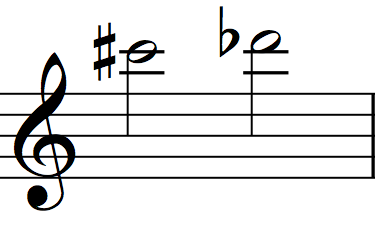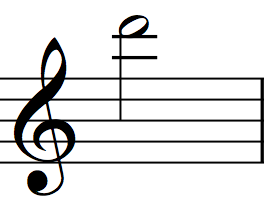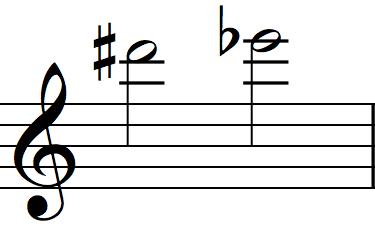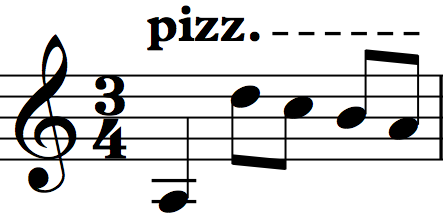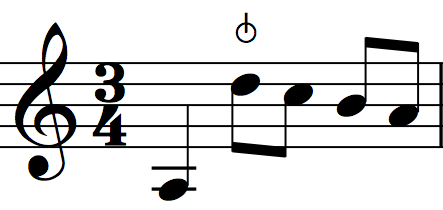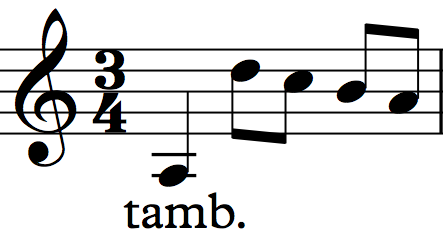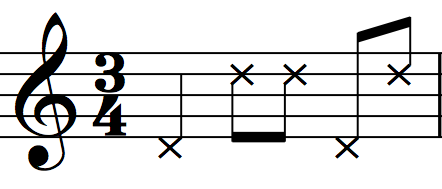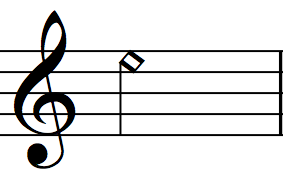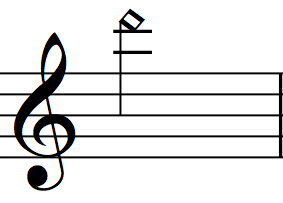17 More Notes & Extended Techniques
INTRODUCTION
In this unit you will learn more fretted notes on the first string and a few common extended techniques. Generally speaking, extended techniques produce distinctive pitches, noises and colors. They broaden the guitar’s range of expression.
NOTATIONS
Notes
The Notes ‘C♯’ and ‘D♭’
‘C♯’ and ‘D♭’ are enharmonics. To play ‘C♯’ or ‘D♭’, fret the ninth fret on the first string.
The Note ‘D’
‘D’ sits on top of the second leger line above the staff. To play ‘D’ fret the tenth fret on the first string.
The Notes ‘D♯’ and ‘E♭’
‘D♯’ and ‘E♭’ are enharmonics. To play ‘D♯’ or ‘E♭’, fret the eleventh fret on the first string.
Extended Techniques
Mute
The mute is typically notated with an “x” in place of a notehead, suggesting a slightly pitched, mostly noisy, sound. The mute sound is produced when the fretting-finger applies less pressure on the string than normal.
Pizzicato (AKA Palm Muting)
The pizzicato is notated with the abbreviation, pizz. It is often used along with succession of dashes to indicate an entire pizzicato phrase or section. Typically, a pizzicato is produced by resting the exterior side of the plucking-hand on the string near the bridge. Many guitarists refer to this technique as palm muting.
Snap (AKA Bartok Pizzicato)
The snap is notated by writing the word snap into the score. The same technique can also be referred to as the Bartok pizzicato which is represented with a circle pierced by a vertical line. The effect is produced by gripping the string, lifting it away from the guitar face and releasing it to snap against the fretboard.
Tambora (AKA Tambour)
The tambora (AKA tambour) is typically notated with the abbreviation, tamb.. A tambora is produced by hitting the strings near the bridge, usually with the thumb of the plucking-hand.
Golpe
The term golpe originated in flamenco but is also employed in non-flamenco styles to indicate any type of percussive sound resulting from striking the guitar. Often, composers will specify distinct places on the guitar body where golpes should occur. In these cases, ‘x’ noteheads are positioned at different pitch levels on the staff. Most likely, the composer will write a statement to correspond with the score. The statement will include a description of where each x-pitched golpe is to be played on the guitar’s body.
Harmonic
The harmonic shown above can be played at string VI, fret 5.
The harmonic shown above can be played at string V, fret 5
The harmonic shown above can be played at string IV, fret 5
The harmonic is usually represented by a diamond-shaped notehead. The notehead is placed at the harmonic’s sounding pitch, not at the location of its production. The examples above show the sounding pitch and the production location of a few fifth fret harmonics. I suggest you memorize the sounding pitch and production location of these, and other, guitar harmonics. Link to a description of natural harmonics forthcoming.
Let’s Play |
Sight-Reading Tip
People learn to sight-read at different rates and in different ways. Do not be discouraged if you think you are taking too long to master a concept, or if you are taking longer than other guitarists. When it comes to sight-reading, there is no such thing as a normal path of development. Sight-reading requires countless facets of a person’s physical, intellectual and emotional being. Perhaps the dynamic and holistic aspects of the skill account for the typical guitarist’s progression in unpredictable leaps of dramatic improvement followed by periods of agonizing stagnation.
Further, there is no point at which a guitarist can claim to have mastered the skill of sight-reading. The best sight-readers are the ones who strive to continually refine this skill. Sight-reading is always contextual. Today you might sight-read a sarabande by J.S. Bach with no mistakes, but tomorrow you might sight-read a siguiriyas by Paco de Lucía with difficulty. Therefore, the best goal for sight-reading practice is not some over-intellectualized concept of mastery. Instead, allow your goal to be revealed in practice, as you experience increasing ease of understanding, processing and playing notated music.
In the end, consistent practice is the only thing that distinguishes good sight-readers from average sight-readers. So resist the temptation to compare yourself to others and refocus that energy on your regular practice. Appreciate your unique path of development and celebrate the small successes along the way. If you continue in this manner, you will eventually sight-read at the level you desire, and beyond… .
Checklist for Sight-Reading
- Count the beats out loud (including the &).
- Keep going (even if you make a mistake).
- Maintain your best playing posture.
- Look at the score, not your hands.
- Play with the feel of the meter.
- Play patterns instead of individual notes (AKA chunk).
- Cultivate a calm demeanor.
- Have fun!
Let’s Play Rhythms |
Attitude Tip
“Puss, though I own thy quicker parts,
Things are not always done by starts,
You may deride my awkward pace,
But slow and steady wins the race.”
–from “The Hare and Tortoise” by Robert Lloyd
Exercise 17.1: Score
Exercise 17.1: Audio
Exercise 17.2: Score
Exercise 17.2: Audio
Exercise 17.3: Score
Exercise 17.3: Audio
Exercise 17.4 requires two different types of golpes. Tap the face of the guitar for the lower note and the side of the guitar for the higher one.
Exercise 17.4: Score
Exercise 17.4: Audio
Let’s Play Patterns |
Attitude Tip
What really matters is what we do after the mistake, and how we try to make things right again. –Fred Rogers
Exercise 17.5: Score
Exercise 17.5: Audio
Exercise 17.6 features the twelfth fret natural harmonics introduced in the text above.
Exercise 17.6: Score
Exercise 17.6: Audio
Exercise 17.7 features the fifth fret natural harmonics introduced in the text above.
Exercise 17.7: Score
Exercise 17.7: Audio
Let’s Play Duets |
Attitude Tip
There are not shortcuts because there is no end. –Kyuzo Mifune
Pavana VI by Luis de Milán: Score
Pavana VI: Audio
Ricercare Secondo by Giacomo Gorzanis: Score
Ricercare Secondo: Audio
Pavana V by Luis de Milán: Score
Pavana V: Audio
Let’s Play Compositions |
These compositions are under the Creative Commons Attribution-NonCommercial 4.0 International License (CC BY-NC 4.0).
Attitude Tip
The dragon cloud turns
into a bunny rabbit.
So, why worry?
–C. Green
Night Crawler by Peter Yates: Score
Night Crawler: Audio
Nataraja by Paweł Kuźma: Score
Nataraja: Audio
Congratulations!
You have completed this unit! If you kept up with the beat and accurately played approximately 70% of the pitches and rhythms, you are ready for the next unit. Feel free to repeat the exercises. However, do not play them so often that you memorize them. Once you memorize the notation, you are no longer developing the skill of sight-reading.

